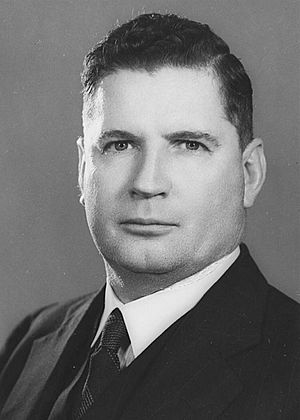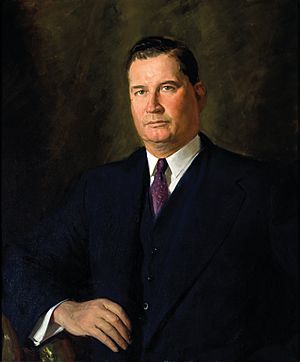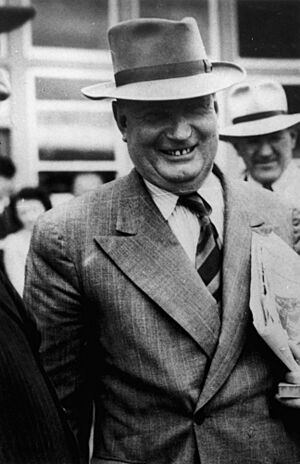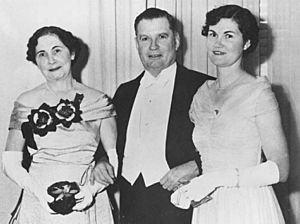Arthur Fadden facts for kids
Quick facts for kids
Arthur Fadden
|
|||||||||||||||||||||
|---|---|---|---|---|---|---|---|---|---|---|---|---|---|---|---|---|---|---|---|---|---|

Fadden in 1940
|
|||||||||||||||||||||
| 13th Prime Minister of Australia | |||||||||||||||||||||
| In office 29 August – 7 October 1941 |
|||||||||||||||||||||
| Monarch | George VI | ||||||||||||||||||||
| Governor-General | Lord Gowrie | ||||||||||||||||||||
| Preceded by | Robert Menzies | ||||||||||||||||||||
| Succeeded by | John Curtin | ||||||||||||||||||||
| Leader of the Opposition | |||||||||||||||||||||
| In office 7 October 1941 – 23 September 1943 |
|||||||||||||||||||||
| Prime Minister | John Curtin | ||||||||||||||||||||
| Preceded by | John Curtin | ||||||||||||||||||||
| Succeeded by | Robert Menzies | ||||||||||||||||||||
| Treasurer of Australia | |||||||||||||||||||||
| In office 28 October 1940 – 7 October 1941 |
|||||||||||||||||||||
| Prime Minister | Robert Menzies Arthur Fadden |
||||||||||||||||||||
| Preceded by | Percy Spender | ||||||||||||||||||||
| Succeeded by | Ben Chifley | ||||||||||||||||||||
| In office 19 December 1949 – 9 December 1958 |
|||||||||||||||||||||
| Prime Minister | Robert Menzies | ||||||||||||||||||||
| Preceded by | Ben Chifley | ||||||||||||||||||||
| Succeeded by | Harold Holt | ||||||||||||||||||||
| Leader of the Country Party Elections: 1943, 1946, 1949, 1951, 1954, 1955 |
|||||||||||||||||||||
| In office 12 March 1941 – 26 March 1958 |
|||||||||||||||||||||
| Deputy | John McEwen | ||||||||||||||||||||
| Preceded by | Archie Cameron | ||||||||||||||||||||
| Succeeded by | John McEwen | ||||||||||||||||||||
| Deputy Leader of the Country Party | |||||||||||||||||||||
| In office 16 October 1940 – 12 March 1941 |
|||||||||||||||||||||
| Leader | Vacant | ||||||||||||||||||||
| Preceded by | Harold Thorby | ||||||||||||||||||||
| Succeeded by | John McEwen | ||||||||||||||||||||
|
|||||||||||||||||||||
|
|||||||||||||||||||||
| Personal details | |||||||||||||||||||||
| Born |
Arthur William Fadden
13 April 1894 Ingham, Queensland Colony |
||||||||||||||||||||
| Died | 21 April 1973 (aged 79) Brisbane, Queensland, Australia |
||||||||||||||||||||
| Resting place | Mount Thompson Crematorium | ||||||||||||||||||||
| Political party | Country (from 1936) | ||||||||||||||||||||
| Other political affiliations |
CPNP (until 1936) | ||||||||||||||||||||
| Spouse |
Ilma Thornber
(m. 1916) |
||||||||||||||||||||
| Children | 4 | ||||||||||||||||||||
| Education | Walkerston State School | ||||||||||||||||||||
| Occupation | Accountant | ||||||||||||||||||||
Sir Arthur William Fadden (born 13 April 1894, died 21 April 1973) was an important Australian politician. He was the 13th Prime Minister of Australia for a short time, from 29 August to 7 October 1941. He also led the Country Party from 1940 to 1958. For almost ten years, he served as the Treasurer of Australia, managing the country's money.
Arthur Fadden was born in Ingham, Queensland. He grew up in Walkerston and left school when he was 15. He became a town clerk in Mackay in 1916. After a big cyclone in 1918, he moved to Townsville and started his own accounting business. He was elected to the Townsville City Council in 1930. In 1932, he became a member of the Queensland Parliament.
He lost his state seat in 1935 but soon won a spot in the federal parliament in 1936. In 1940, he became a minister in Robert Menzies' government. After some ministers died in a plane crash, Fadden became the Minister for Air and Minister for Civil Aviation. He was also chosen as the acting leader of the Country Party and became the Treasurer.
Fadden was acting prime minister for four months in 1941 while Menzies was away. He became popular for being easy to get along with. In August 1941, Menzies resigned, and Fadden became prime minister. However, he was prime minister for only 39 days. He was replaced by John Curtin after losing a vote in parliament. After this, Fadden became the Leader of the Opposition for two years. He later gave this role back to Menzies after a big election loss in 1943.
When Menzies became prime minister again in 1949, Fadden served as Treasurer for a second time. He held this job until he retired from politics in 1958. Only one other person has been Treasurer for longer. Arthur Fadden rose very quickly in Australian politics, becoming prime minister just 11 years after being a private citizen. He was the first prime minister born in Queensland. He was also the only Country Party member to become prime minister with his own clear support, not just as a temporary leader.
Contents
Early Life and Career
Growing Up in Queensland
Arthur Fadden was born in Ingham, Queensland, on 13 April 1894. He was the oldest of ten children. His parents, Annie and Richard, were from Ireland. Arthur moved to Walkerston, Queensland when he was young. His father was in charge of the local police station there.
He had a normal country childhood. Sadly, three of his younger brothers and sisters died in accidents. Arthur only went to Walkerston State School. He left school at 15. His first jobs included collecting cane beetles and making sound effects at the local cinema. He later worked at the Pleystowe Sugar Mill.
Becoming an Accountant
In 1913, Fadden moved to Mackay, Queensland to work as an assistant town clerk. He was chosen out of many people who applied. In 1916, he became the town clerk himself. He was said to be the youngest town clerk in Australia. He tried to join the army but was not allowed due to his health.
In 1918, a big cyclone hit Mackay, killing many people. Fadden helped with the relief efforts. Later that year, he moved to Townsville and started his own accounting business. He had studied accounting through a course from Melbourne.
At first, Fadden found it hard to make enough money as an accountant. But he found a special way to help his clients with their taxes. His business then grew very well. He opened another office in Brisbane. In 1930, Fadden was elected to the Townsville City Council.
Starting in Politics
Queensland State Politics
In 1932, Arthur Fadden was elected to the Queensland Parliament. He represented the area of Kennedy. He won by a very small number of votes. He was the only person from his party to win a seat from the Labor Party that year.
In parliament, Fadden became known for questioning how the government handled its money. He said they were not being clear about their finances. His speeches were impressive, and he even wrote articles for a newspaper.
In 1935, the election boundaries changed, making it very hard for Fadden to win his seat again. He decided to run in a different area but lost. He believed the government had changed the boundaries to stop him from winning.
Moving to Federal Politics
After losing his state seat, Fadden moved to Brisbane and went back to accounting. In 1936, he joined the Queensland Country Party. Later that year, he was elected to the Australian House of Representatives. He won a special election for the area of Darling Downs. He had no previous connection to this area. He won the seat again in the 1937 federal election.
Working with Robert Menzies
In 1939, the Prime Minister, Joseph Lyons, died. Robert Menzies became the new leader of the United Australia Party (UAP). The Country Party leader, Earle Page, spoke badly about Menzies. Because of this, Fadden and some other members left the Country Party for a short time.
Later, they rejoined the Country Party. In March 1940, Menzies and the new Country Party leader, Archie Cameron, agreed to work together again. This meant some Country Party members could become ministers. Fadden was chosen as an assistant minister.
In August 1940, Fadden was very lucky. He was supposed to be on a plane that crashed, killing three government ministers. But he decided to take a train instead. After the crash, Fadden became the Minister for Air and Minister for Civil Aviation. He also continued as an assistant minister.
The 1940 election resulted in no party having a clear majority. The UAP and Country Party could stay in power with the help of two independent members of parliament. On 16 October, the Country Party voted to remove Archie Cameron as leader. John McEwen and Earle Page both wanted to be leader. They were tied after three votes. Fadden was then asked to be the temporary leader as a compromise. He also became the deputy leader. He was chosen because he was good at making deals and working with others.
As the acting leader of his party, Fadden became the unofficial Deputy Prime Minister. He also became the Treasurer in October 1940. He presented his first budget a month later. This budget included big tax increases because of the ongoing war. It was not popular, but after some changes, it was passed.
Becoming Prime Minister
In August 1941, Robert Menzies resigned as Prime Minister. The UAP and Country Party decided to choose Fadden as their leader. This was unusual because the Country Party was the smaller party. Fadden became Prime Minister on 29 August and also remained Treasurer. He was the only Country Party member to be Prime Minister with his own clear support.
However, Fadden's time as Prime Minister was difficult from the start. Even people in his own party thought it would be short. It was said that Fadden decided not to move into The Lodge, the official Prime Minister's home, because he thought he wouldn't be there long.
On 3 October, the two independent members who had been supporting the government voted against Fadden's budget. They were unhappy with how Menzies had been treated. Because of this, Fadden's government had to resign. This was the last time an Australian government had to resign after losing a vote in parliament. Fadden joked that he was like the Flood, saying he had "reigned for 40 days and 40 nights."
The Governor-General did not want to call another election so soon, especially with the war getting closer. He asked the Labor leader, John Curtin, if he had enough support to govern. The two independent members agreed to support Curtin. So, Curtin became Prime Minister on 7 October.
After Being Prime Minister
Leader of the Opposition
After his government fell, Fadden was chosen as the Leader of the Opposition. This happened even though the UAP was usually the main party. Menzies then resigned as the UAP leader. The UAP chose 79-year-old former Prime Minister Billy Hughes as its new leader.
The parties in opposition struggled. Fadden found it hard to compete with John Curtin, who was very popular during the war. In the 1943 Australian federal election, the parties lost badly. They won only 19 seats, with Fadden's Country Party getting only seven. Fadden took responsibility for this big loss. He then gave the Opposition leadership back to Menzies.
Rebuilding the Coalition
After another election loss in 1946, Fadden started working closely with Menzies again. Menzies had created the new Liberal Party of Australia. Some thought the Country Party might join the Liberals, but Fadden wanted his party to stay independent.
Fadden was a strong conservative and against communism. In the late 1940s, he often said that the Labor Party was "socialist." This allowed Menzies to seem more moderate. Fadden was known for his friendly and cheerful public manner. People often called him "Artie."
Treasurer Again
The Liberal and Country parties won a big victory in the 1949 Australian federal election. Fadden became Treasurer again in Menzies' second government. He moved to a new area called McPherson on the Gold Coast.
In the early 1950s, prices were rising quickly. This meant Fadden had to introduce some tough budgets. But generally, the economy was doing well, especially for farmers.
Before the 1954 Australian federal election, Fadden was in a serious car accident. He was pulled from the car unconscious and spent election day in hospital. He had injuries to his face, head, and legs, needing five operations.
Fadden resigned as leader of the Country Party on 26 March 1958. John McEwen took over as leader. At the same time, Fadden announced he would retire from politics at the 1958 election. He gave his last budget speech on 5 August. He officially left his job as Treasurer on 9 December, even though the election was in November.
It was unusual for the Treasurer to be from the smaller party in the government and not be its current leader. Fadden and Earle Page are the only Country Party members who have been Treasurers in governments led by non-Labor parties. Since Fadden retired, every Treasurer in a Liberal-led government has been a Liberal.
Later Life and Legacy
After leaving parliament, Fadden worked in many different businesses. He visited Japan and tried to help a Japanese company get a license to export iron ore. He also became chairman of a company that built houses. He joined the boards of several companies, including a real estate firm and an ice-cream maker.
In 1969, Fadden wrote a book about his life called They Called Me Artie. He also wrote a short account of his time as Prime Minister, called "Forty days and forty nights."
Fadden had some health problems in his retirement. He died from leukaemia on 21 April 1973, at the age of 79. A special funeral was held for him in Brisbane.
Personal Life
On 27 December 1916, Arthur Fadden married Ilma Nita Thornber. She worked as a milliner, making hats. They had four children: Gordon, John, Mavis, and Betty. Sadly, his oldest son Gordon died in 1956 when he was 34.
Arthur Fadden was also a Freemason, joining a lodge in Mackay in 1915. He later joined another lodge in Brisbane in 1937 and remained a member until shortly before he died. He was also part of an acting group in Mackay when he was younger.
Honours and Recognition
Fadden was made a member of the Privy Council of the United Kingdom in 1942. This gave him the title "Right Honourable." In 1951, he was made a Knight Commander of the Order of St Michael and St George (KCMG). King George VI personally knighted him in London in 1952. Fadden remembered that the King accidentally called him "Sir William" at first, but then corrected it to "Sir Arthur."
In 1958, he was given an even higher honour, Knight Grand Cross (GCMG), when he retired from politics. In 1972, the University of Queensland gave him an honorary Doctor of Laws degree.
After Fadden's death, a suburb in Canberra called Fadden was named after him. A federal election area, the Division of Fadden, was also named in his honour. In 1975, a postage stamp with his picture was issued by Australia Post. In 1976, the Sir Arthur Fadden Memorial Garden was created in Brisbane.
See Also
 In Spanish: Arthur Fadden para niños
In Spanish: Arthur Fadden para niños
- Fadden Ministry







